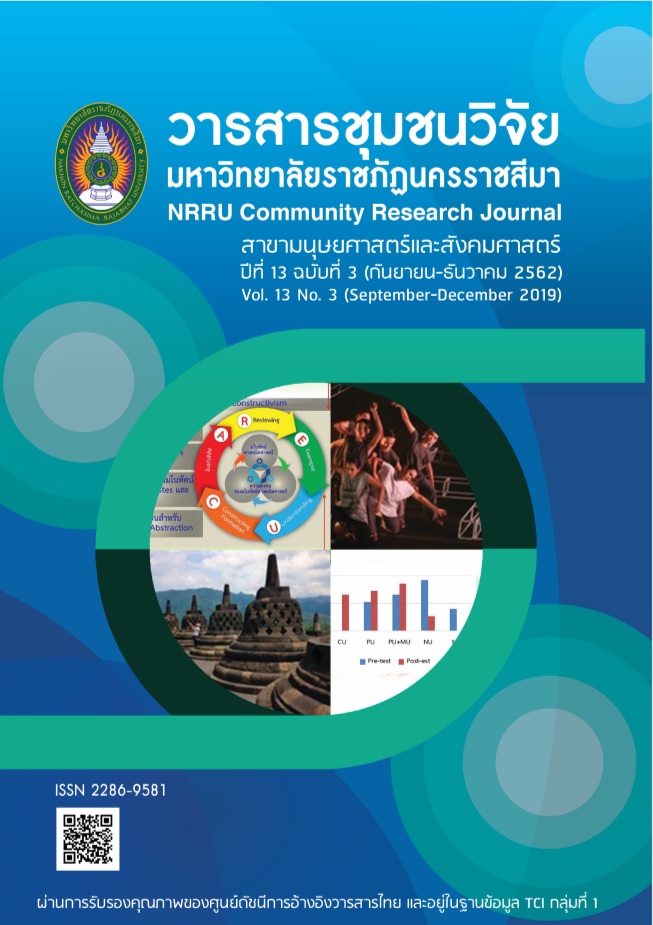การศึกษาการประยุกต์ห้องเรียนกลับด้านเพื่อพัฒนาสมรรถนะการแก้ปัญหาแบบร่วมมือของผู้เรียนในรายวิชาเคมี ระดับมัธยมศึกษาตอนปลาย เรื่อง ปริมาณสารสัมพันธ์
DOI:
https://doi.org/10.14456/nrru-rdi.2019.54คำสำคัญ:
การจัดการเรียนรู้ตามแนวคิดห้องเรียนกลับด้าน, สมรรถนะการแก้ปัญหาแบบร่วมมือ, การศึกษากรณีศึกษา, ปริมาณสารสัมพันธ์บทคัดย่อ
งานวิจัยนี้เป็นงานวิจัยศึกษา ก) แนวทางการจัดการเรียนรู้ตามแนวคิดห้องเรียนกลับด้านร่วมกับการใช้กรณีศึกษาเพื่อส่งเสริมสมรรถนะการแก้ปัญหาแบบร่วมมือสำหรับนักเรียน และ ข) ผลของการพัฒนาสมรรถนะการแก้ปัญหาแบบร่วมมือในเนื้อหา เรื่อง ปริมาณสารสัมพันธ์ โดยใช้รูปแบบการวิจัยเป็นวิจัยปฏิบัติการในชั้นเรียน ผู้เข้าร่วมวิจัย คือ นักเรียนชั้นมัธยมศึกษาปีที่ 4 จำนวน 28 คน ได้มาจากการคัดเลือกแบบเจาะจง เก็บข้อมูลโดยใช้แผนการจัดการเรียนรู้รวมทั้งใบกิจกรรม แบบบันทึกสะท้อนผลการจัดการเรียนรู้ แบบสังเกตพฤติกรรมการแก้ปัญหาแบบร่วมมือ และแบบทดสอบวัดสมรรถนะการแก้ปัญหาแบบร่วมมือ (IOC อยู่ระหว่าง 0.67-1.00) วิเคราะห์ข้อมูลเชิงคุณภาพโดยใช้การวิเคราะห์เนื้อหาและตรวจสอบความน่าเชื่อถือของข้อมูลเชิงคุณภาพด้วยวิธีการตรวจสอบแบบสามเส้า ผลการศึกษาแสดงให้เห็นว่า ก) แนวทางการจัดการเรียนรู้ตามแนวคิดห้องเรียนกลับด้านร่วมกับการใช้กรณีศึกษาเพื่อพัฒนาสมรรถนะการแก้ปัญหาแบบร่วมมือ ควรมี 5 ขั้นหลักที่สำคัญ ได้แก่ 1) ขั้นทบทวนปัญหา: ครูนำเสนอปัญหาและใช้คำถามเพื่อตรวจสอบความเข้าใจของนักเรียนต่อปัญหาและกระตุ้นให้นักเรียนร่วมกันค้นหาความรู้ที่เกี่ยวข้องกับปัญหา 2) ขั้นวิเคราะห์ปัญหา: ครูกระตุ้นให้นักเรียนแต่ละกลุ่มร่วมกันระบุปัญหาเฉพาะที่ต้องการแก้ไข 3): ขั้นสร้างแนวทางการแก้ปัญหา: แต่ละกลุ่มค้นหาวิธีการแก้ปัญหาที่หลากหลายและระบุข้อดี ข้อเสียและข้อจำกัดของแต่ละวิธี 4) ขั้นการตัดสินใจ: นักเรียนแต่ละกลุ่มร่วมกันตัดสินวิธีแก้ปัญหาที่ดีที่สุดโดยพิจารณาความเหมือนและความต่างในแต่ละวิธีและวางแผนเพื่อลงมือปฏิบัติตามวิธีการที่ได้เลือกไว้ และ 5) ขั้นสะท้อนผลลัพธ์: แต่ละกลุ่มเสนอวิธีการแก้ปัญหา แลกเปลี่ยนความคิดและคำแนะนำเพื่อพัฒนาแนวทางการแก้ปัญหารวมทั้งการทำงานเป็นกลุ่ม ข) นักเรียนพัฒนาสมรรถนะการแก้ปัญหาแบบร่วมมือได้มากที่สุด คือ สมรรถนะการสร้างและรักษาระเบียบของกลุ่ม สมรรถนะการสร้างและเก็บรักษาความเข้าใจร่วมกัน และสมรรถนะการเลือกวิธีดำเนินการที่เหมาะสมในการแก้ปัญหา ตามลำดับ
References
Care, E., Griffin, P., & McGaw, B. (2012). Assessment and teaching of 21st century skills. Springer.
Centre for the New Economy and Society. (2018). The Future of Jobs Report 2018. World Economic Forum 2018. Retrieved May 15, 2017, from http://www3.weforum.org/docs/ WEF_Future_of_Jobs_2018.pdf (In Thai)
Chatsupakul, K. (2003). Group Activities in School. Bangkok: Thanathud printing. (In Thai)
Choi, I., & Lee, K. (2009). Designing and implementing a case-based learning environment for enhancing ill-structured problem solving: Classroom management problems for prospective teachers. Educational Technology Research and Development, 57(1), 99-129.
Cholsin, J. (2016). The action research for developing learning management on stoichiometry based on stem approach emphasized engineering design process to promote collaborative problem solving competency. Journal of Education Naresuan University, 20(2), 32-46. (In Thai)
Ge, X., & Land, S. M. (2003). Scaffolding students’ problem-solving processes in an ill-structured task using question prompts and peer interactions. Educational Technology Research and Development, 51(1), 21-38.
Grypp, L., & Luebeck, J. (2015). Rotating solids and flipping instruction. Mathematics Teacher, 109(3), 186-193.
Hayat, A. Z., & Wahyu, W. (2018). Comparison of peer-tutoring learning model through problem-solving approach and traditional learning model on the cognitive ability of grade 10 students at SMKN 13 Bandung on the topic of Stoichiometry. Journal of Physics: Conference Series, 1013(1), 012208. IOP Publishing.
Hesse, F., Care, E., Buder, J., Sassenberg, K., & Griffin, P. (2015). A framework for teachable collaborative problem solving skills. In Assessment and teaching of 21st century skills (pp. 37-56). Springer, Dordrecht.
IPST. (2016). Collaborative Problem Solving : How is PISA measured? FOCUS in PISA. Retrieved May 15, 2017, from https://pisathailand.ipst.ac.th/issue-2018-25/. (In Thai)
Jantarakantee, E. (2016) Instruction for Promoting Argumentation Skill in Science Classroom. Journal of Yala Rajabhat University, 11(1), 217-232. (In Thai)
Kijkuakul, S. (2014). Scientific learning management: The guide for teachers in 21st century. Petchaboon : Chunladit printing Press. (In Thai)
Lo, C. K., Lie, C. W., & Hew, K. F. (2018). Applying “First principles of instruction” as a design theory of the flipped classroom: Findings from a collective study of four secondary school subjects. Computers & Education, 118, 150-165.
Moraros, J., Islam, A., Yu, S., Banow, R., & Schindelka, B. (2015). Flipping for success: Evaluating the effectiveness of a novel teaching approach in a graduate level setting. BMC Medical Education, 15(1).
OECD. (2013). Draft collaborative problem solving framework. Paris : OECD.
_______. (2017). PISA 2015 COLLABORATIVE PROBLEM-SOLVING FRAMEWORK. Paris : OECD.
Petrillo, J. (2016). On flipping first-semester calculus: a case study. International Journal of Mathematical Education in Science and Technology, 47(4), 573-582.
Rahman, A. A., Aris, B., Rosli, M. S., Mohamed, H., Abdullah, Z., & Mohd Zaid, N. (2015).
Significance of Preparedness in flipped classroom. Advanced Science Letters, 21(10), 3388–3390.
Schleicher, A. (2017). Are school systems ready to develop students’ social skills?. Retrieved May 15, 2017, from http://oecdeducationtoday.blogspot.com/2017/11/are-school-systems-ready-to-develop.html
Srivirojn, W. (2014). The Development of Instructional Model in Stoichiometry based on Integrated Inquiry Training and Cooperative Learning to Enhance Critical Thinking for Upper Secondary Students in an Enrichment Science Classroom. Journal of Education Naresuan University, 16(3), 1-13. (In Thai)
Sungkapun, S. (2014). Why do you need skills in the 21st century? 21st century skill articles. Doctoral’s thesis, Mahasarakham university. Retrieved May 15, 2017, from https://www. srn2.go.th/attachments/article/145/รวมบทความ.pdf (In Thai)



